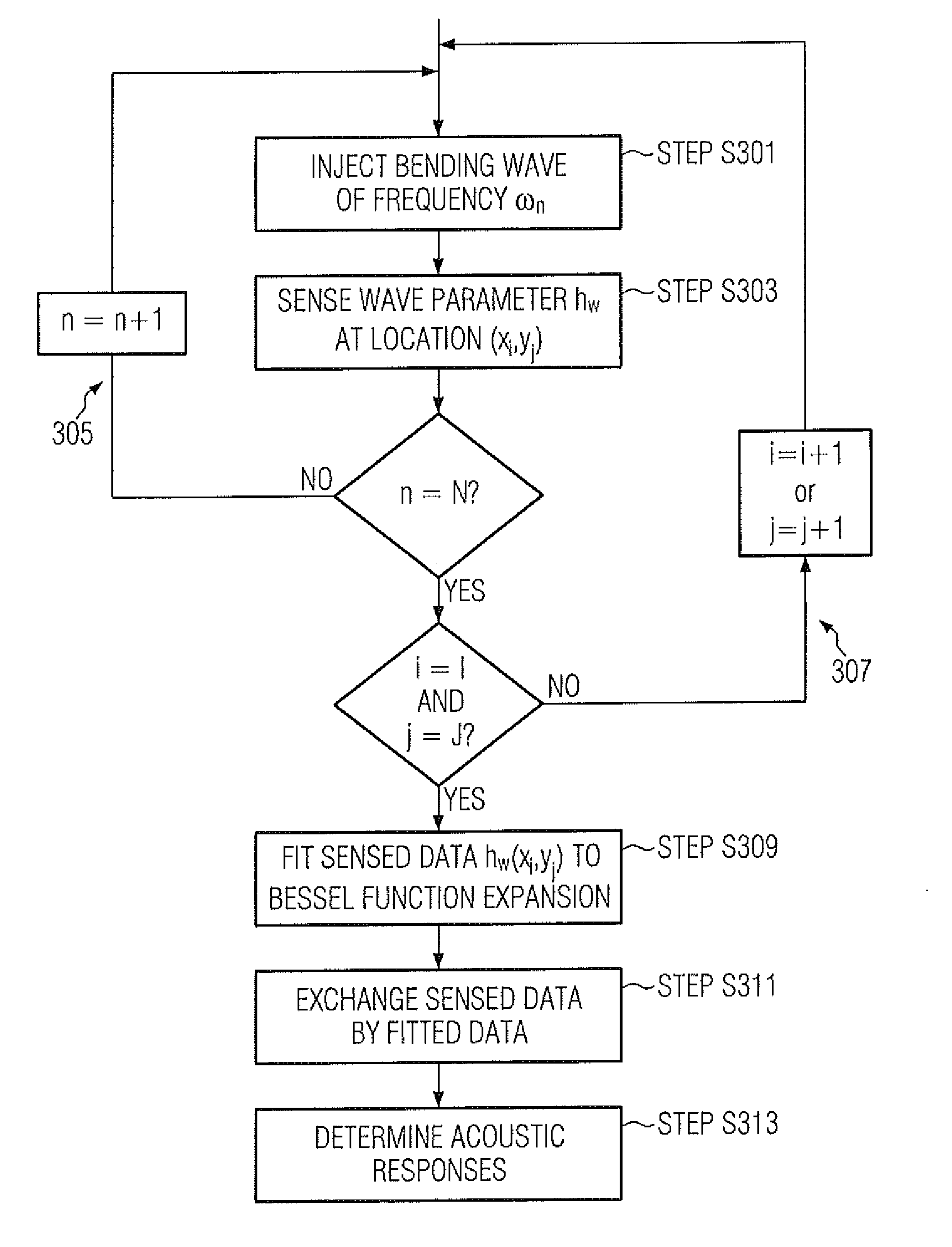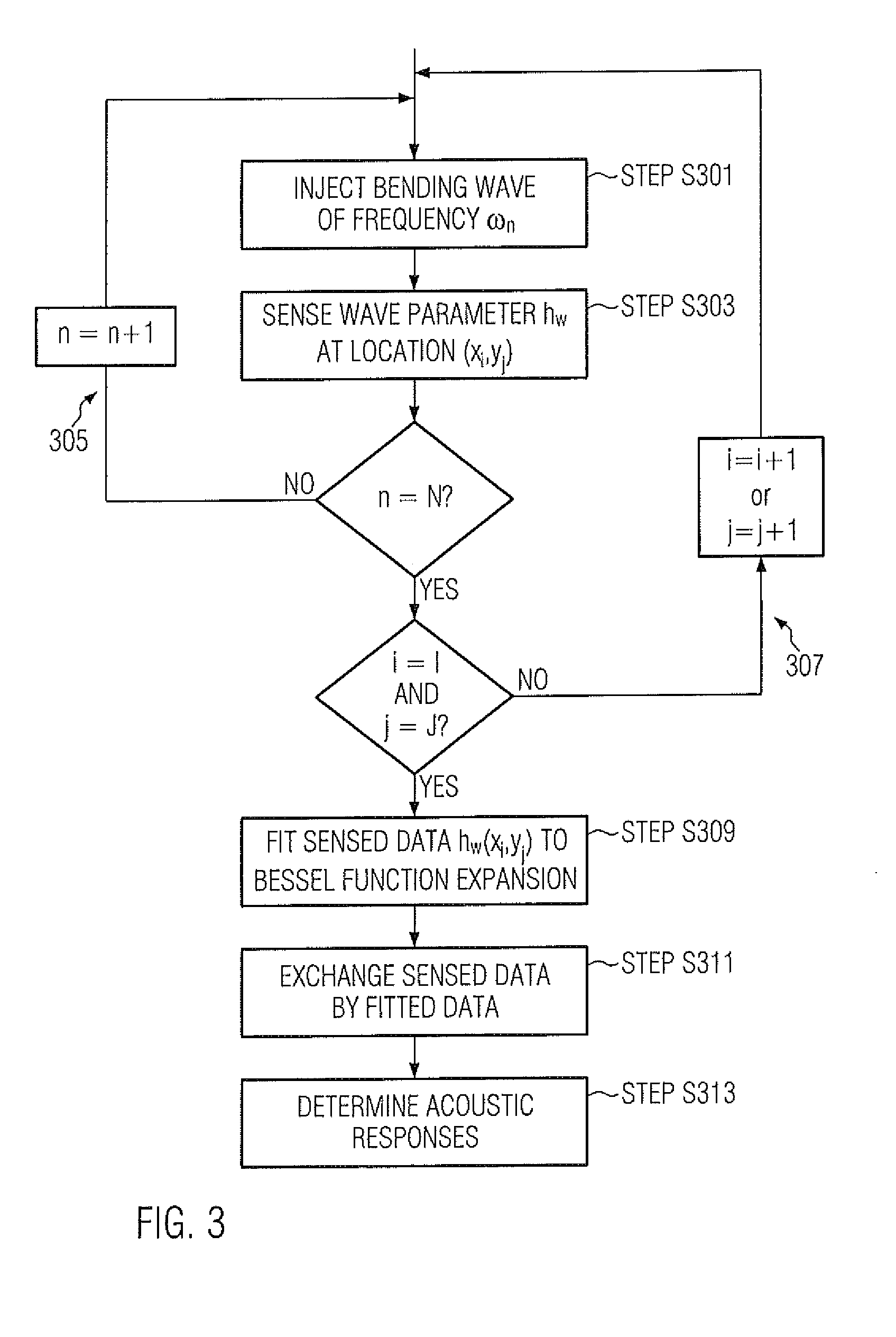Method and a Touch Sensing Device for Implementing the Method
a touch sensing device and method technology, applied in the field of methods and touch sensing devices for implementing methods, can solve the problems of not always being able to identify all unwanted contributions, tedious and time-consuming activities, etc., and achieve the effect of reducing noise contributions, improving the signal-to-noise ratio of sensed signals, and reducing noise in signals
- Summary
- Abstract
- Description
- Claims
- Application Information
AI Technical Summary
Benefits of technology
Problems solved by technology
Method used
Image
Examples
first embodiment
[0028]FIG. 2 illustrates a two-dimensional schematic view of a touch sensing device 201 using a method for reducing noise in a signal sensing a bending wave propagating in an object, here a touch sensing device 201, according to the invention.
[0029]The touch sensing device 201 comprises an interaction surface 203, e.g. a glass plate or the like, and at least one transducer 205. In this embodiment, the touch sensing device 201 comprises two transducers 205a, 205b, e.g. piezoelectric transducers, capacitive piezoelectric transducers, magnetostrictive piezoelectric transducers, electromagnetic piezoelectric transducers, acoustic velocimeters, accelerometers, optical sensors, MEMS or any device capable of transforming an acoustic signal into an electric one and visa versa. The coupling between the transducers 205a and 205b and the interaction surface 203 is achieved by a fastening means, which can be a tape, glue or the like. Depending on the configuration of the device, more than two ...
fifth embodiment
[0038]If hω(xi, yj) is measured at each calibration grid location (xi, yj), the inventive method proposes to reduce noise contributions in the measurement by fitting the measured data to a function that obeys the laws of physics underlying the acoustic wave propagation in the interaction surface 203. Using a function satisfying bending wave propagation properties to fit the measured data, noise contributions to the sensed signals not satisfying the bending wave propagation properties can be reduced.
[0039]In fact, the measured data has to obey the Helmholtz Equation which can be expressed as follows:
∂2hω / ∂X2+∂2hω / ∂Y2+k2hω(X,Y)=0 (1)
[0040]In an alternative notation, Helmholtz Equation can also be written as follows:
(∇2+k2)hω(X,Y)=0 (2)
[0041]The wave number k is determined by the bending wave dispersion relation given in Equation 7 as already mentioned above.
k=ω[12(1-υ2)ρEh2]1 / 4(3)
[0042]The Helmholtz Equation (2) and the dispersion relation (3) apply to bending waves propagating in ...
second embodiment
[0054]FIG. 5 illustrates a method for reducing noise in a signal sensing a bending wave propagation in an object according to a
[0055]The method according to the second embodiment can be carried out to establish calibration data of a touch sensitive device 201 as illustrated in FIG. 2. In contrast to the first embodiment, the second embodiment proposes not to inject bending waves using the transducers 205a and 205b of the touch sensor device 291, but to use a robotized calibration device, being a tool for applying a mechanical excitation to the interaction surface 203 at a grid location (xi, yj). The device can comprise a rigid tip, such as a pike or a small ball made of any rigid material such as metals or the like, to transmit a predetermined excitation tap upon the interaction surface 203. The device may further comprise a transducer to convert an electric signal into a mechanical excitation, such as an electromagnetic shaker, a piezoelectric transducer, capacitive piezoelectric t...
PUM
 Login to View More
Login to View More Abstract
Description
Claims
Application Information
 Login to View More
Login to View More - R&D
- Intellectual Property
- Life Sciences
- Materials
- Tech Scout
- Unparalleled Data Quality
- Higher Quality Content
- 60% Fewer Hallucinations
Browse by: Latest US Patents, China's latest patents, Technical Efficacy Thesaurus, Application Domain, Technology Topic, Popular Technical Reports.
© 2025 PatSnap. All rights reserved.Legal|Privacy policy|Modern Slavery Act Transparency Statement|Sitemap|About US| Contact US: help@patsnap.com



